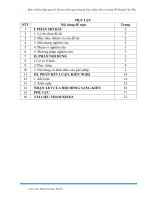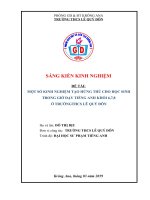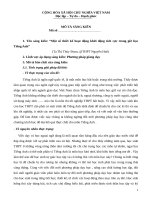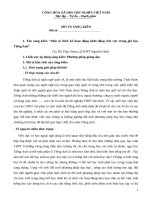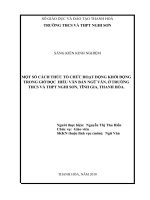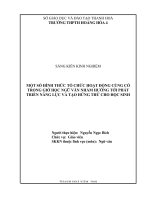MỘT SỐ GIẢI PHÁP TỔ CHỨC CẶP, NHÓM HIỆU QUẢ TRONG GIỜ DẠY TIẾNG ANH THEO PHƯƠNG PHÁP MỚI (Some useful measures for organising group and pairwork effectively in the english class)
Bạn đang xem bản rút gọn của tài liệu. Xem và tải ngay bản đầy đủ của tài liệu tại đây (199.42 KB, 13 trang )
sở giáo dục và đào tạo hng yên
TRƯờNG THPT khoái châu
============
Đề tài:
MT S GII PHP T CHC CP, NHểM HIU QU
TRONG GI DY TING ANH THEO PHNG PHP MI
(Some useful measures for organising group and pairwork
effectively in the english class)
Họ và tên : Lơng Anh Đức
Chức vụ : Giáo viên
Đơn vị công tác : Tổ ngoại ngữ
Năm học: 2007 - 2008
PART I : INTRODUCTION
*Reason for choosing the topic
1
In the time of rapid developement of technology and
industry, foreign languages have really become “a golden
key” for the exchange and cooperation between countries all
over the world. In Vietnam nowadays, the demand of foreign
languages, expecially English increases higher and higher.
English has become a compulsory subject at school as well as
universities.But it seems that teaching and learning English at
many secondary school in Vietnam is not very effective. One
of the most important reasons is unsuitable methods in
teaching and learning. The teachers of English often meet
difficulties in approaching new methods of teaching foreign
languages communicatively. How to organise groupwork or
pairwork effectively is also the problem which they often
meet. Recognizing the importance of groupwork and
pairwork, I’ve chosen this topic in the hope of finding out
some useful measures in organising groupwork and pairwork
activities in the class.
* Aims of the study.
- To introduce how to pairwork and groupwork and to show
the advantages of working in pairs and groups.
- To show how to organise pair and groupwork effectively
and how to deal withinitial problems that may arise
- To show how pair and groupwork can be used for various
classroom activities
- To give teachers confidence in using pair and groupwork
themselves.
* Scope of the study :
This study is only concerned with ways of organising
activities in the class rather than with teaching techniques.
* Theoretical background
2
Begin by making sure that teachers understand what
pairwork and groupwork involve :
- In pairwork , the teacher devides the whole class into
pairs. Every student works with his or her partner, and all
the pairs work at the same time ( it is sometimes called
“simultaneous pairwork” ) . Point out that this is not the
same as public or open pairwork, with pairs of students
speaking in turn in front the class.
- In groupwork, the teacher divides he class into small
groups to work together ( usually four or five students in
each group ). As in pair group, all te groups work at the
same time.
Point out that pairwork and groupwork are not reaching methods
but ways of organnising the class. They can be used far many
different kinds of activities, and are naturally more suitable for
some activities than for others.
3
PART II
SOME MEASURES OF ORGANISING PAIRWORK
AND GROUPWORK EFFECTIVELY
I) ADVANTAGES AND PROBLEMS WHEN CONDUCTING
PAIRWORK GROUPWORK
For certain type of activity, pairwork and groupwork have
a number of advantages over working with the whole class
together. So what are the advantages of using pairwork and
groupwork ? And what problems might there be ?
Here are some advantages as well as some problems teachers
might meet during the process of organising pairwork or
groupwork.
Advantages Problems
-More language
practice
-Noise
-Students are more
involved
-Students make
mistakes
-Students feel secure -Difficult to control
-Students help each
other
I can analyse more about the advantages and give out some
measures to overcome the problems.
i) More language practice : Pairwork and groupwork
give students far more chance to speak English. Refer to
the request : working in pairs, each student makes seven
4
sentences ( either a question or an answer ).If the
excercise were done “round the class”, students would
only say one sentence each, and in a large class many
students would say nothing at all.
ii) Students are more involved : Working in pairs or
groups encourages students to be more involved and to
concentrate on the task. Refer to the above request : if
this discussion were conducted with the whole class
together, it would be dominated by a few students and
the others would lose the interest.
iii) Students feel secure : Students feel less anxiety when
they are working “privately” when they are “on show”
in front of the whole class. Pairwork and groupwork can
help shy students who would never say anything in a
whole-class activity.
iv) Students help each other : Pairwork and groupwork
encourages students to share ideas and knowledge. In a
reading activity students can help each other to explore
the meaning of the text; in a discussion activity students
can give each other new ideas.
Following are some measures to overcome the problems
i) Noise : Obviously, pairwork and groupwork in a large
class will be noisy, and this cannot be helped.
But : -Usually student themselves are not disturbed by he
noise; it is more noticeble to the teacher standing at the side
or to someone in the next room.
-The noise created by pairwork and groupwork is usually
good noise students using English, or engaged in a learning
task.
5
ii) Students make mistakes: During a pair or group
activity, the teacher cannot control all the language used, and
should not try to do so. When doing controlled language
practice in pairs or groups, the number of mistakes can be
reduced :
-By giving enough preperation. The activity can be done with
the whole class first, and pairwork used for the final stage.
-By checking afterwards. The teacher can ask some pairs or
groups what they said, and then correct the mistakes if
necessary.
iii) Difficult to control class : The teacher has less control
over what students are doing in pairwork or groupwork than
in a normal class. To stop activities getting out of control, it
is important to :
- give clear instructions about when to start, what to
do and when to stop ;
- give clear defined task which do not continue for
too long ;
- set up a routine, so hat students accept the idea of
working in pairs or groups, and know exactly what
to do.
II) ORGANNISING PAIRWORK
*The first measure :
We should study the following activity in which a teacher
organised the pairwork activity.We can see the process of
organising the pairwork activity and find out that she was not
successful :
Teacher A had an immediate class. She presented “ like /
don’t like” and then she used free practice in pairs :
6
Exercise : Likes and dislikes
Pairwork : Ask what your friend like and
doesn’t like.
Ask about :
Food sport music school
subjects
The three processes below show what she did before,
during and after the activiy( We used to use these methods
before )
Before During After
T : Alright-
Exercise
3.Sit in
pairs.Ask
and answer
the
questions
T: (Sit in and
do nothing)
T : Everyone
finished ?
Good. Now
look at
exercise 4
Do you think the activity was successful ?
What do you think might have gone wrong ?
What could she do to make it more successful ?
I can say that the activity was not successful and I can give
some suggestions to make it more succesful:
1- She could prepare for the pair work by establishing
what the questions and answers should be. She could also
demonstrate the pairwork by asking questions round the class, or
by getting one pair of students to ask and answer in front of the
class. The students would know exactly what to do.
2-She could be more active in starting the pairwork.
Instead of just saying “ Work in pais” ,she could show students
7
who to work with, check that everyone had a partner, and check
that everyone had started working in pairs
3- During the activity she could move quickly round the
class to check that students were talking and to see when they
finished.
4- Instead of waiting everyone to finish, she could stop the
activity. Then there would be no chance for students to get
bored and start talking about the other things.
5- After the pairwork she could ask some pairs what they
said,or ask a few pairs to repeat their conversation in front of the
class.
*The second measure:
Now we study the demonstration below to know how the
activity could be conducted. Pay particular attention to the way
of organising the pairwork :
A possible procedure :
i) Introduce the exercise and show what questions and
answers students can give :
T : Now. You’re going to talk about things you like and
thinks you don’t like. Look at the exercise. What questions can
you ask ? What about food ?
Sts : What food do yo like ?
T : Good . What answer could you give ?
Sts : I like chocolate.
I like eating fruit.
I like biscuits.
(and so on)
Wrte the basic questions on the board :
What (food) do you like ?
8
ii)Ask a few questions round the class, to show the kind
of conversation students might have :
T : What kind of music do you like ? Nam ?
St : I like pop music.
T : Pop music ? Which singer do you like best ?
(and so on)
If you like, ask two students have similar conversations, while
the other listen.
iii)Divide the class into pairs.
Teacher : Now you are going to work in pairs. ( Indicate
pairs by pointing. If there are single students left without a partner, make
group of three.) . Ready ? Ask and answer the questions. First one
person ask all the questions, then change round. Start now.
iv)Students work in pairs . Move quickly round
the class .Checking that everyone is talking ( but do not try
to Correct the mistakes, as this will interrupt the activity ).
v) When most pairs have finished, stop the activity. Ask
a few students what their partners said :
T : Lan, tell me about Mai.What does she like ?
St : She says she likes ice cream, pop music and
swimming. And she likes English, but not every lesson.
She doesn’t . She doesn’t like writing.
*The third measure:
One of the most important things to organise the pairwork
or groupwork effectively is that how to dividing the
class.Pairwork and groupwork, like any other class activity, can
quickly become a routine. Once students are used to it and have
regular working partners, it can be organised quickly and easily
( for example, simply by saying “Now get into your groups” or
9
“Do this in pairs”). The first few times that teachers try pair or
groupwork are very important-they need to be more careful
instructions andknow exactly how they will devide the class
Here are some best ways of forming pairs and group in the class.
First of all , we study the situation below.
Here are two rows of a class of 50 students. The desk are
fixed, and the students sit on chairs. How could you divide the
class into :
-Pairs ? or Small Groups ? What instuctions would you
give ?
O O O O O O
8 9 10 11 12 13
O O O O O O O
1 2 3 4 5 6 7
Following are the ways to form pairs and groups in the class
shown above.
For pairwork : Most students could work work with the
person next to them. Student 7 could turn round and work with
student 13, and student 8, 9, and 10 work as three together. Or
student 10 could move to work with student 11, and the front
row could be divided into two pairs and one three.
For groupwork : Students could work in threes and fours
along this row- his would be easy to organise but would make it
10
difficult for students to work well as a group,as they would be in
a straight line. Or students in he front row could turn round and
form groups with those behind ( either three groups of three and
one of four or two groups of four and one of five )
* The forth measure:
( Some useful activities in pair or groupwork in the class ).
i) Partern practice : This can be done in pairs in the
same way as the “likes / dislikes” activity
demonstrated above. Any controlled oral practice can
be done first with the whole class, and then in pairs.
ii) Practising short dialogues : Acting the short
dialogues can very easily be done in pairs, with little
chance of students makng mistakes. It can be done
first with pairs of students in front of the class, and
then with all the students working in pairs at the
same time.
iii) Reading a text and answering the questions :
Students can discuss questions in pairs or groups and
then read the text; or they can read the text silently,
and then ask and answer the questions in pairs or
groups. This is a good way of involving the whle
class in answering the questions.
iv) Short writing exercise : Students can sit in groups
and decide together what to write- one student acts as
“secretary”. This can be difficult to organise but in a
large class it has the advantage that students correct
each other’s mistakes and he teacher only has a few
papers to mark at the end. Pairwork can be used for
correcting written work ( e.g. homework )- students
11
sit in pairs and correct what what their partner has
written.
v) Discussions : With more advanced classes,discussion
can be conducted in groups. It is important to define
the discussion clearly, and to ask each group to
report their conclusions afterwards.
vi) Grammar exercises : Students can do grammar
exercises orally in pairs; the teacher goes through the
answer afterwards with the whole class, and students
write the exercise for homework. This is more
interesting and productive than students doing
exercises alone, in silence.
PART III : CONCLUSION
In conclusion, nowadays in Vietnamese
secondary schools, the teaching of English in
general does not meet the requirement of social
development. One of the reasons causing this
problem is that the methods as well as techniques
in teaching are not appropriate and *exible. In my
opinion, there are no methods or techniques that
show absolute usefulness for the teaching unless
the teacher can stimulate his/ her students and
arose student’s interest in learning.And what I
hope to do in this study just to upon and pesent
some measures for better English teaching in
secondary schools. Due to the short time as well as
limited knowledge of he author on this matter,
mistakes and errors are invitable. So the thesis has
left much room for further discussion, criticism and
improvement by teacher and those who may
12
concern. All remarks, comments, suggestions are
deeply apreciated and well received.
13


